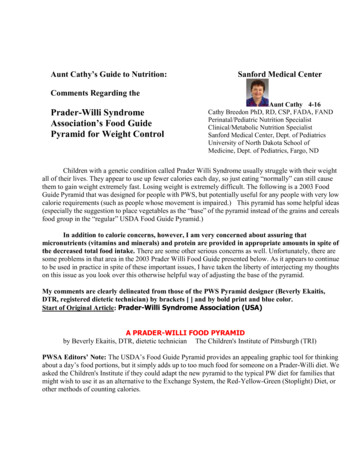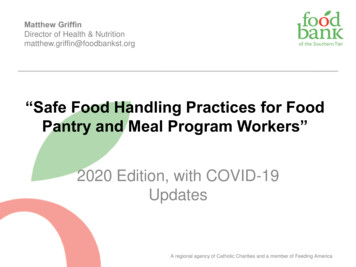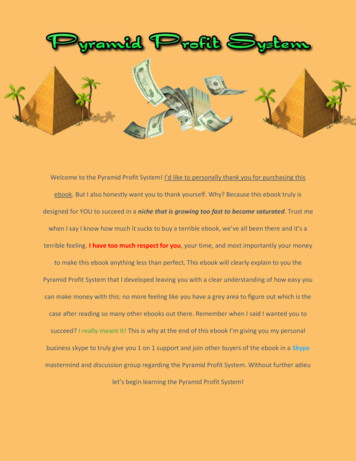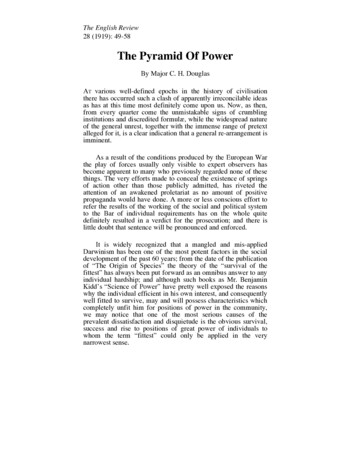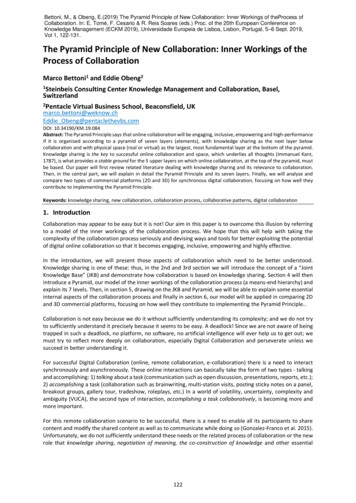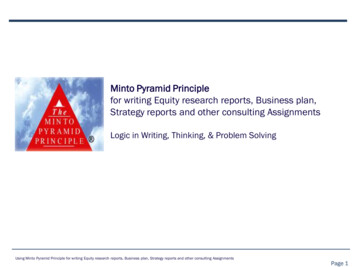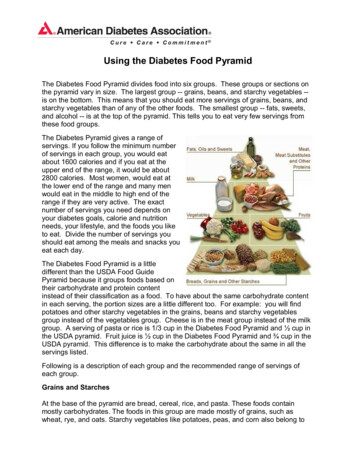
Transcription
Using the Diabetes Food PyramidThe Diabetes Food Pyramid divides food into six groups. These groups or sections onthe pyramid vary in size. The largest group grains, beans, and starchy vegetables is on the bottom. This means that you should eat more servings of grains, beans, andstarchy vegetables than of any of the other foods. The smallest group fats, sweets,and alcohol is at the top of the pyramid. This tells you to eat very few servings fromthese food groups.The Diabetes Pyramid gives a range ofservings. If you follow the minimum numberof servings in each group, you would eatabout 1600 calories and if you eat at theupper end of the range, it would be about2800 calories. Most women, would eat atthe lower end of the range and many menwould eat in the middle to high end of therange if they are very active. The exactnumber of servings you need depends onyour diabetes goals, calorie and nutritionneeds, your lifestyle, and the foods you liketo eat. Divide the number of servings youshould eat among the meals and snacks youeat each day.The Diabetes Food Pyramid is a littledifferent than the USDA Food GuidePyramid because it groups foods based ontheir carbohydrate and protein contentinstead of their classification as a food. To have about the same carbohydrate contentin each serving, the portion sizes are a little different too. For example: you will findpotatoes and other starchy vegetables in the grains, beans and starchy vegetablesgroup instead of the vegetables group. Cheese is in the meat group instead of the milkgroup. A serving of pasta or rice is 1/3 cup in the Diabetes Food Pyramid and ½ cup inthe USDA pyramid. Fruit juice is ½ cup in the Diabetes Food Pyramid and ¾ cup in theUSDA pyramid. This difference is to make the carbohydrate about the same in all theservings listed.Following is a description of each group and the recommended range of servings ofeach group.Grains and StarchesAt the base of the pyramid are bread, cereal, rice, and pasta. These foods containmostly carbohydrates. The foods in this group are made mostly of grains, such aswheat, rye, and oats. Starchy vegetables like potatoes, peas, and corn also belong to
this group, along with dry beans such as black eyed peas and pinto beans. Starchyvegetables and beans are in this group because they have about as much carbohydratein one serving as a slice of bread. So, you should count them as carbohydrates for yourmeal plan.Choose 6 11 servings per day. Remember, not many people would eat the maximumnumber of servings. Most people are toward the lower end of the range.Serving sizes are:1 slice of bread¼ of a bagel (1 ounce)½ an English muffin or pita bread1, 6 inch tortilla¾ cup dry cereal½ cup cooked cereal½ cup potato, yam, peas, corn, or cooked beans1 cup winter squash1/3 cup of rice or pastaVegetablesAll vegetables are naturally low in fat and good choices to include often in your meals orhave them as a low calorie snack. Vegetables are full of vitamins, minerals and fiber.This group includes spinach, chicory, sorrel, Swiss chard, broccoli, cabbage, bok choy,brussels sprouts, cauliflower, and kale, carrots, tomatoes, cucumbers, and lettuce.Starchy vegetables such as potatoes, corn, peas, and lima beans are counted in thestarch and grain group for diabetes meal planning.Choose at least 3 5 servings per day.A serving is:1 cup raw½ cup cookedFruitThe next layer of the pyramid is fruits, which also contain carbohydrates. They haveplenty of vitamins, minerals, and fiber. This group includes blackberries, cantaloupe,strawberries, oranges, apples, bananas, peaches, pears, apricots, and grapes.Choose 2 4 servings per dayA serving is:½ cup canned fruit1 small fresh fruit2 tbs dried fruit1 cup of melon or raspberries1 ¼ cup of whole strawberries
MilkMilk products contain a lot of protein and calcium as well as many other vitamins.Choose non fat or low fat dairy products for the great taste and nutrition without thesaturated fat.Choose 2 3 servings per dayA serving is:1 cup non fat or low fat milk1 cup of yogurtMeat and Meat SubstitutesThe meat group includes beef, chicken, turkey, fish, eggs, tofu, dried beans, cheese,cottage cheese and peanut butter. Meat and meat substitutes are great sources ofprotein and many vitamins and minerals.Choose from lean meats, poultry and fish and cut all the visible fat off meat. Keep yourportion sizes small. Three ounces is about the size of a deck of cards. You only need4 6 ounces for the whole dayChoose 4 6 oz per day divided between mealsEqual to 1 oz of meat:¼ cup cottage cheese1 egg1 Tbsp peanut butter½ cup tofuFats, Sweets, and AlcoholThings like potato chips, candy, cookies, cakes, crackers, and fried foods contain a lotof fat or sugar. They aren't as nutritious as vegetables or grains. Keep your servingssmall and save them for a special treat!Serving sizes include:½ cup ice cream1 small cupcake or muffin2 small cookiesThe Diabetes Food Pyramid makes it easier to remember what to eat. For a healthymeal plan that is based on your individual needs, you should work with a registereddietitian (RD) with expertise in diabetes management.
The Diabetes Food Pyramid: Grains & StarchesThe message today: Eat more whole grains! Whole grains and starches are good foryou because they have very little fat, saturated fat, or cholesterol. They are packed withvitamins, minerals, and fiber. Yes, foods with carbohydrate starches, vegetables,fruits, and dairy products will raise your blood glucose more quickly than meats andfats, but they are the healthiest foods for you. Your doctor may need to adjust yourmedications when you eat more carbohydrates. You may need to increase your activitylevel or try spacing carbohydrates throughout the day.On average Americans eat around 40 45% of our calories as carbohydrate. This is amoderate amount of carbohydrate, not high. Currently some controversy aboutcarbohydrates is raging due to a few new diet books. These books encourage a lowcarbohydrate, high protein and moderate fat intake. These diets are not in synch withthe American Diabetes Association nutrition recommendations, which are based onyears of research and clinical experience. In addition, these trendy diets are hard tofollow year after year.A way to see how carbohydrates affect your blood glucose is to monitor your blood1&1/2 to 2 hours after meals. Checking your blood glucose at this point tells you howhigh your blood glucose went from the carbohydrates you ate. For good diabetescontrol, keep your after meal blood glucose levels at 180 or below.Easy ways to include whole grains, beans, and starchy vegetables into your meal plan:··········In a meatloaf or meatball recipe, substitute some grain, such as oatmeal, bulguror brown rice, for some of the meat.Add noodles, peas, or beans to a vegetable soup.Prepare a hearty bean or pea soup. Eat some and divide the rest into individualportions; store the soup in the freezer for a quick meal.When you're cooking grains, make enough for extra servings. Then toss them onsalads, into soups or casseroles, or reheat them as leftovers.Eat whole grain cold cereal as a snack and pack the small boxes for snacks onthe run.Open a can of garbanzo beans (chickpeas) or kidney beans and add them to asalad, tomato sauce or a three bean salad.Treat yourself to great tasting whole grain bread with meals, for a snack or as themain course at breakfast.Add crunch to a salad or casserole with fat free tortilla or potato chips.Have pretzels or light (in fat) popcorn for a snack.Buy breads with at least 2 to 3 grams of fiber and hot and cold cereals with atleast 4 grams of fiber per serving.
The Diabetes Food Pyramid: VegetablesWhen it comes to vegetables, people with diabetes, should eat at least three servings aday. Vegetables are healthy, chock full of vitamins and minerals, and some give youmuch needed fiber. The best part: vegetables are naturally low in calories if you arecareful not to top them with butter, sour cream, cream soups, or cheese sauces.Remember, non starchy vegetables such as spinach, broccoli, lettuce, greens, carrots,chilies, peppers and tomatoes (those in this food group) do contain a small amount ofcarbohydrate 5 grams per serving.Easy ways to eat your vegetables:···········Keep frozen and canned vegetables on hand to know you always havevegetables at the ready.Make double and triple portions; at a serving one day and have one ready to gofor the next.Blanch (quick cook and chill) a head of broccoli or cauliflower, break it intopieces, place in a plastic container and have a ready supply for the week, hot orcold.Keep a bag of pre cut or baby carrots around grab a handful as a snack, packthem with lunch, throw them into stew, or microwave for a quick vegetable.Microwave or sauté onions and peppers to put more vegetables into a tomatosauce.Toss extra sautéed vegetables on a frozen pizza.Make a big salad to last a few days, store in the refrigerator in a plastic container.Add vegetables into sandwiches not just the old lettuce and tomato, try alfalfasprouts, sliced red onion, sliced cucumbers, sliced yellow squash or zucchini, redpeppers, or leftover grilled vegetables.Add vegetables to an omelette or scrambled eggs sauté onions, peppers,mushrooms, tomatoes and add some fresh herbs.Drink tomato juice, V 8 or Bloody Mary mix as a vegetable.In a tomato sauce, cut the amount of meat you use in half, and add morevegetables onions, peppers, mushrooms, eggplant, zucchini or others.Adapted from the book Diabetes Meal Planning Made Easy. Written by Hope S.Warshaw, MMSc, RD, CDE, a nationally recognized expert on healthy eating anddiabetes.
The Diabetes Food Pyramid: FruitQuestions about fruit keep coming up. Will fruit juice increase blood glucose levelsmore quickly than a piece of fruit? Should you avoid fruit in the morning because yourblood glucose might be higher than at other times in the day? Is it better to eat fruit withmeals rather than snacks?All carbohydrates, whether rice, potatoes or fruit juice, raise blood glucose about thesame. In general, an equal amount of carbohydrate (15 grams) such as 1/2 cupgrapefruit juice or 4 slices of Melba toast, should raise blood glucose at about the samespeed and about the same amount.However, that varies based on several factors whether you eat a piece of fruit after ahigh fat meal or sip fruit juice on an empty stomach, what your blood glucose is whenyou eat the fruit, whether the fruit is cooked or raw, how much diabetes medication youhave in your body, etc.Also, people have individual differences. So, your challenge is to find out how fruitworks in your body. Does eating fruit in the morning make it more difficult to keep yourblood glucose controlled through the day? Does one particular kind of fruit send yourblood glucose soaring? Or does a piece of fruit as an afternoon snack give you justenough carbohydrate to last until dinner? Use blood glucose monitoring to answer yourquestions about how fruit works in your body.Eat some fruit each day for vitamins, minerals, and fiber. Be honest with yourself aboutyour serving sizes. It is easy to drink a few extra ounces of fruit juice or to call a hugepiece of fruit 1 serving when it is at least 2. The steps to take to track your response tofruit are: Check the serving size, eat your fruit, and check your blood glucose levelabout 1&1/2 to 2 hours later.Easy ways to eat more fruit:········Put slices of banana or peaches on cold cereal.Add dry fruit (such as raisins, apricots, or apples) when cooking hot cereal.Keep a plastic container full of cut up fruit have some at breakfast or for asnack topped with plain or fruited non fat, sugar free yogurt (to get a bit morecalcium).Take one or two pieces of fruit from home each day to eat with lunch and as anafternoon snack or on your way home to knock the edge off your ravenousappetite.Keep dried fruit, raisins, figs, apricots, peaches, pears, etc., around. Use it for asnack, try it as fuel for long hikes or bike rides, or stash in your desk or locker.Toss a few raisins, pieces of apple, dried apricot, or pineapple chunks on asalad.Have canned or jarred fruit in the pantry applesauce, peaches, pears andpineapple for starters.Toss fruit into entrees pineapple in stir fry or on make your own pizza; fresh ordried cranberries or peaches in chicken, or apricots or apples in pork dishes.
···Combine fruit with vegetables crushed pineapple in coleslaw, raisins in carrotsalad, make a Waldorf salad with apples, raisins, walnut and celery.Serve fruit with the main course applesauce with pork chops or roast,pineapple with ham, low sugar cranberry sauce with chicken.Grill fruit on skewers and serve as dessert with a few ginger snaps or vanillawafers or serve as part of the main course.Adapted from the book Diabetes Meal Planning Made Easy. Written by Hope S.Warshaw, MMSc, RD, CDE, a nationally recognized expert on healthy eating anddiabetes.
The Diabetes Food Pyramid: ProteinPeople with diabetes have no less or more need for protein than the general public.Plus, they have a greater risk of heart disease earlier in life. One of the most importantnutrition guidelines to follow is "eat less saturated fat." A quick way to do that is to cutdown on animal protein foods meats, whole milk dairy foods, and high fat cheeses(such as cheddar, brie, or American). If you cut down on animal protein, you can bepretty sure you will cut down on saturated fat and cholesterol as well.Make Protein S t r e t c hA way to make small servings of protein appear larger is to incorporate them into anentree such as low fat ground beef or turkey sausage in a tomato sauce served overpasta. For ideas, take lessons from cultures that have long practiced making a smallamount of protein feed many mouths Chinese stir fry, Mexican burritos, or Japanesesukiyaki. This accomplishes several pyramid goals less meat, less fat, more starchesand more vegetables. From time to time, take these recipes one step further andeliminate meat all together.Easy ways to eat less protein·········Split a sandwich with a friend in restaurants by asking for extra pieces of bread oradditional rolls. Share a salad plate, for example tuna or chicken salad, andrequest bread or rolls be served on the side.In fast food restaurants, order single, regular, or junior size sandwiches and stayaway from the doubles and triples.Order a take home container (doggie bag) if you order an entrée with a servingof meat that is more than 6 ounces. Split the serving when your plate is setbefore you. Take it home for lunch or dinner tomorrow.Make your own sandwiches with less protein and more vegetables.Take up more room on your plate with whole grains, starches, and vegetables.Leave room on the side for meat. The meat portion should take up only 1/4 ofyour plate. Think of meat as a side dish, not the main course.Buy smaller quantities (just what you need for the purpose) so you eat less.Load sandwiches with raw vegetables (easier with pita bread because you canstuff the pocket).Start the day without a serving of meat at breakfast. Try a bowl of cereal, a smallbagel, or an English muffin.Gather recipes that use less meat and more grains, beans and vegetables tryto make a new one each week or two.Adapted from the book Diabetes Meal Planning Made Easy. Written by Hope S.Warshaw, MMSc, RD, CDE, a nationally recognized expert on healthy eating anddiabetes
The Diabetes Food Pyramid: FatThe total amount of fat you eat should be based on the foods you like and your goals foreating healthy and blood lipid (blood fats) and glucose control. You need anindividualized eating plan. For example, a young athlete with type 1 diabetes mightneed 4,000 calories a day during football season. He probably needs to eat 40% of hiscalories from fat, just to get all those calories. Even though he is eating a higher numberof calories as fat, he still should choose foods with less saturated fat and cholesteroland more monounsaturated fat (such as olive oil, canola oil, avocado, nuts, or olives).Conversely, a small woman with type 2 diabetes who needs to lose some weight, mayneed to keep the amount of fat she eats at about 25% of calories or below to achieveher nutrition and diabetes goals.One of the most important diabetes nutrition guidelines is to hold saturated fat to lessthan 7% of calories. Why? Because saturated fat raises blood cholesterol. High bloodcholesterol is a risk factor for heart disease. People with diabetes have more frequentheart disease. Limiting saturated fat could lower your risk for this diabetes complication.Also, some people with abnormal blood lipids (fat) and a high triglyceride might benefitfrom increasing the amount of monounsaturated fats they eat. As for cholesterol, keepit to 200 mg or less each day. Some foods high in cholesterol are egg yolks and organmeats (liver or kidney).How To Cut Down On Saturated FatConcentrate on decreasing the amount of:Meats·Purchase lean cuts.·Cut off all visible fat prior to cooking.·Use preparation methods that get rid of more fat, such as grilling.·Eat 2 3 ounce portions (cooked). This serving is about the size of the palm ofyour hand, a deck of cards, or a mayonnaise jar lid.Poultry·Take off the skin either before or after cooking.Seafood·Prepare with small amounts of fat.·Eat 2 3 ounce portions (cooked).Cheese
·Limit the amount you eat.·Buy part skim, or reduced fat cheeses.Butter··Use tub margarine.Use butter on occasion, maybe in a recipe.Milk/Yogurt·Use the fat free (skim) varieties.Processed Foods·Read the labels of processed foods and check for tropical oils (such as palm orcoconut), and see how far down on the ingredient list they fall. Ingredients arelisted in descending order of predominance in the product. The ingredient used inthe greatest quantity is listed first, and the ingredient used in the smallestquantity is listed last.How to tank up on monounsaturated fats······Monounsaturated fats are known as the good guys. Monounsaturated fats offerthe benefit of lowering cholesterol, while not decreasing the body's goodcholesterol (HDL).Stock canola and/or olive oil in your cupboard. Use these oils to sauté, cook,prepare salad dressing or bake.Throw a few nuts on foods salads, desserts, stir fries.Use a slice or two of avocado on a salad, to garnish a casserole, or forguacamole as a Mexican topping.Use a few olives on a relish plate, to toss in a salad, as a garnish.Buy canola or olive oil based commercial salad dressings, canola basedmargarine and mayonnaise or make your own with olive or canola oil.Easy ways to spare and skim the fat····Use fat free or no more than 1% milk.Take advantage of light and reduced fat cheeses. Find out which products youlike best. Sometimes you just need to use less of the regular to get the taste youenjoy.If a recipe calls for cheese and you want to use a regular type, buy a sharpvariety and use a smaller quantity. The sharper taste gives more flavor with asmaller amount.Buy the low fat, light, and fat free products that taste good to you. You mighthave to experiment with several margarine, butter (or blends), cream cheese,cottage cheese, mayonnaise, and sour cream. Remember, these products are
·······not calorie free. Be sure to read the Nutrition Facts Label to learn more aboutthe product.Buy the low fat, reduced calorie or fat free salad dressing that has the taste youlike. No matter what salad dressing you use, don't pour on too much. Remembera 1/4 of a cup can contain as many carbohydrates as a slice of bread.Use low or no sugar jelly or jam instead of margarine or cream cheese on bagel,toast, or muffins.Use plain, fat free yogurt or fat free sour cream instead of regular sour cream add herbs and seasonings to make it tasty. Use it on baked potatoes,vegetables, chicken and fish.Always keep fresh lemon and lime on hand to squirt on vegetables and fish at thetable instead of adding more fat (such as sauces, butter or margarine).When you buy meats, buy lean cuts; trim off excess fat; prepare in low fat andmoist ways.Marinate meats and vegetables in wine, vinegars, seasonings and spices to addflavors without adding fat.Consider using applesauce, prune puree or other dried fruit puree to replace fatin baked goods recipes. Check the back of boxes for some recipes or write to themanufacturer to request recipes.Adapted from the book Diabetes Meal Planning Made Easy. Written by Hope S.Warshaw, MMSc, RD, CDE, a nationally recognized expert on healthy eating anddiabetes.
The Diabetes Food Pyramid: SugarResearch studies show that, gram for gram, sugars, like table sugar, do not raise bloodglucose any more quickly than do other carbohydrates, like potatoes, rice or pasta. Thisresearch holds true for people with type 1 and type 2 diabetes.A variety of factors influence how quickly food is digested. A meal with a large amountof fat or fiber, and lots of raw foods takes more time to digest. The blood glucose levelat the time you eat and how much diabetes medication is in your body has a majorimpact, too.It's Not A Sugar Free For AllIf and when you choose to eat sweets, according to your individual diabetes andnutrition goals, substitute these foods for other carbohydrates in your meal plan. Recallthe nutrition message for all Americans, it is the same for people with diabetes Choose a diet moderate in sugars.To determine the amount of sugars and sweets to eat, answer these questions:1. Is your blood glucose in good control and your hemoglobin A1C at a desirablelevel?2. Are your blood fats in your target range total cholesterol, LDL, HDL andtriglycerides?3. How much do you enjoy sugars and sweets, and how often do you want a smallserving to help you stay on track with your eating plan?Get sugar wise:········Keep the healthy eating guidelines top of mind.Prioritize your personal diabetes goals. Which comes first blood glucosecontrol, weight loss, or lower blood fats. Your priorities dictate how you strike thebalance with sugars and sweets.Choose a few favorite desserts and decide how often to eat these in light of yourpersonal diabetes goals maybe twice a week, just when dining out, or only at aspecial celebration.Note the calories, total fat, saturated fat, and cholesterol of the desserts youprefer. Make your choices with these numbers and your diabetes goals in mind.Quench your sweet tooth with a small portion of your favorite sweet.Split a dessert in a restaurant (ask your server for one serving and four spoons).Take advantage of smaller portions when options present themselves, such as atan ice cream or frozen yogurt shop.Substitute a sugar free sweetened food for the regular hot cocoa or an ice pop.
···Use the Nutrition Facts panel on food labels to determine the number of grams ofcarbohydrate per serving size. This will let you know how to swap a sugary orsweet food in your meal plan for a starch, fruit, or milk.Check blood glucose and observe the affect of different sugars and sweets. Letthis information help you decide what sweets to eat.Keep a watch on hemoglobin A1c and blood fats to see if eating more sweetsleads these number on an unhealthy up swing.Adapted from the book Diabetes Meal Planning Made Easy. Written by Hope S.Warshaw, MMSc, RD, CDE, a nationally recognized expert on healthy eating anddiabetes.
group. A serving of pasta or rice is 1/3 cup in the Diabetes Food Pyramid and ½ cup in the USDA pyramid. Fruit juice is ½ cup in the Diabetes Food Pyramid and ¾ cup in the USDA pyramid. This di fference is to make th
